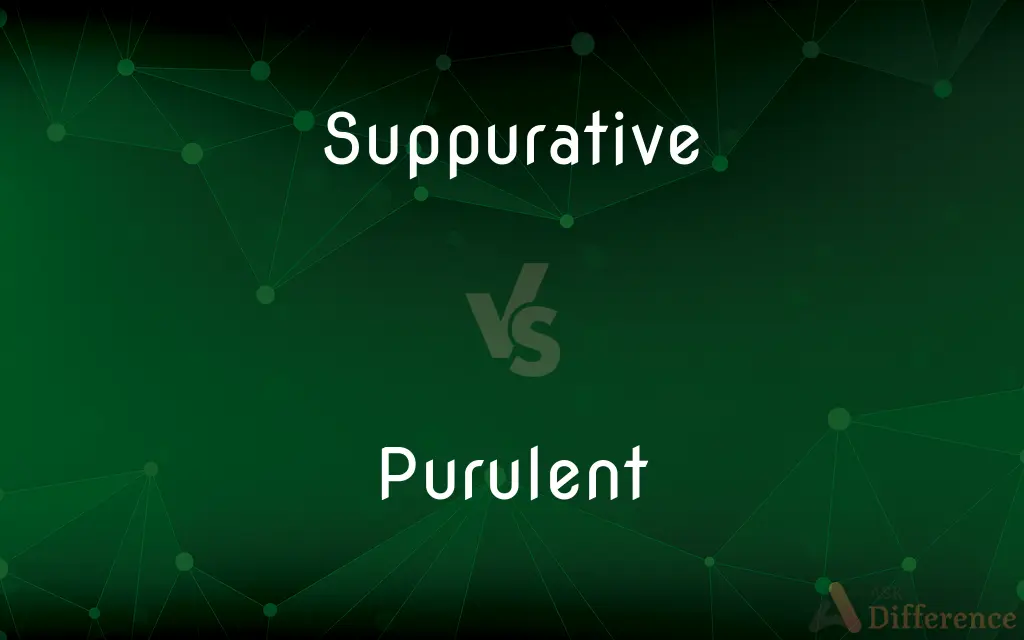Suppurative vs. Purulent — What's the Difference?
By Tayyaba Rehman & Maham Liaqat — Updated on March 31, 2024
Suppurative processes involve the production of pus, focusing on the action or condition of generating pus, while purulent describes the quality or state of containing, discharging, or producing pus.

Difference Between Suppurative and Purulent
Table of Contents
ADVERTISEMENT
Key Differences
In the context of medical terminology, suppurative is often used to describe a type of inflammation or infection that leads to the formation of pus. It highlights the process or action leading to the accumulation of pus. Whereas purulent is used more to describe the physical characteristics of the pus present in an infection or wound, focusing on the appearance, consistency, and sometimes even the amount of pus.
Suppurative conditions are typically indicative of a bacterial infection and the body's immune response to such an infection. This term underscores the dynamic and ongoing nature of the body's battle against invading pathogens. Purulent, by contrast, could be used to describe not just the outcome of suppurative processes but also the specific traits of the pus itself, such as its color, thickness, or odor, which can provide clues about the nature of the underlying infection.
While both terms are related to pus and its formation, suppurative might also imply a more systemic response or a wider area of infection. It suggests an ongoing and potentially spreading condition that requires medical intervention. Purulent, however, might be used in a more localized sense, describing specific areas or materials that are visibly affected by pus, without necessarily implying a systemic condition.
Both suppurative and purulent are important descriptors in the medical field, providing insight into the nature and severity of infections. Understanding the distinction between these terms helps in the accurate description and treatment of infections, with suppurative pointing towards the active process of pus formation and purulent describing the pus-filled result of this process.
Comparison Chart
Definition
Refers to the process or condition leading to the production of pus.
Describes the presence, appearance, or quality of pus.
ADVERTISEMENT
Focus
On the action or process of pus formation.
On the characteristics of the pus itself.
Usage
Used to describe conditions or inflammation leading to pus production.
Used to describe substances, wounds, or discharges that contain or resemble pus.
Implication
Suggests an ongoing response to infection.
Indicates the presence of pus, often without specifying the underlying process.
Context
More commonly used in describing the body’s active fight against infection.
More often refers to the physical attributes of the pus produced.
Compare with Definitions
Suppurative
Describing an inflammatory response that results in pus production.
The suppurative lesion was cleaned and drained by the healthcare provider.
Purulent
Concerned with the presence or characteristics of pus.
A purulent wound often looks swollen, red, and filled with white or yellow pus.
Suppurative
Indicating the presence of pus-forming bacterial infection.
The doctor diagnosed the wound as suppurative and prescribed antibiotics.
Purulent
Indicative of an infection or inflammation producing pus.
Purulent meningitis is a dangerous condition requiring urgent treatment.
Suppurative
Pertaining to or characterized by the generation of pus.
The suppurative infection required immediate surgical intervention.
Purulent
Descriptive of fluids or exudates rich in pus.
The patient's purulent sputum was sent for culture to identify the bacteria.
Suppurative
Related to a process that leads to the accumulation of pus in tissue.
Suppurative otitis media is a common ear infection in children.
Purulent
Relating to or resembling pus.
The purulent material was carefully removed during the dressing change.
Suppurative
Involving the formation of pus due to infection.
Suppurative arthritis is a severe condition that can lead to joint destruction.
Purulent
Containing, discharging, or producing pus.
The purulent discharge from the wound indicated a bacterial infection.
Suppurative
The formation or discharge of pus.
Purulent
Consisting of, containing, or discharging pus
A purulent discharge
Suppurative
Pus.
Purulent
Containing, discharging, or causing the production of pus
A purulent infection.
Suppurative
Causing suppuration: producing, or causing the production of, pus.
Purulent
(medicine) Consisting of pus.
Suppurative
A medicine that causes suppuration.
Purulent
Leaking or seeping pus.
Purulent inflammation
Suppurative
Tending to suppurate; promoting suppuration.
Purulent
Consisting of pus, or matter; partaking of the nature of pus; attended with suppuration; as, purulent inflammation.
Suppurative
A suppurative medicine.
Purulent
Having undergone infection;
A purulent wound
Suppurative
Relating to or characterized by suppuration
Common Curiosities
What causes a purulent infection?
Purulent infections are caused by bacterial invasion that leads to the production of pus.
Can a wound be both suppurative and purulent?
Yes, a wound can be both suppurative, indicating it is producing pus, and purulent, describing the presence of pus.
What is suppurative inflammation?
Suppurative inflammation is a type of inflammatory response where the body produces pus as a defense against infection.
Is purulent discharge a sign of infection?
Yes, purulent discharge is a sign of infection, often indicating bacterial involvement.
Can purulent material be tested to identify the infection?
Yes, purulent material can be cultured to identify the specific bacteria causing the infection.
How do healthcare providers manage purulent wounds?
Healthcare providers manage purulent wounds by cleaning, draining the pus, and administering appropriate antibiotics.
Do purulent and suppurative conditions always require antibiotic treatment?
While antibiotics are commonly used, the specific treatment depends on the infection's severity and location.
How is a suppurative condition treated?
Suppurative conditions are treated with antibiotics, drainage of pus, and sometimes surgery to remove infected tissue.
What does it mean if an exudate is described as purulent?
If an exudate is described as purulent, it means it contains, resembles, or is producing pus.
Are all suppurative infections serious?
While not all suppurative infections are life-threatening, they can become serious if not properly treated.
What differentiates suppurative otitis media from other ear infections?
Suppurative otitis media specifically involves pus formation within the middle ear, distinguishing it from other types of ear infections.
What are common signs of a purulent infection?
Common signs include redness, swelling, warmth, pain, and the presence of pus.
Why is it important to distinguish between suppurative and purulent conditions?
Distinguishing between these conditions helps in determining the severity of the infection and guiding appropriate treatment strategies.
Can suppurative processes lead to abscess formation?
Yes, suppurative processes can lead to abscess formation, where pus accumulates within a tissue cavity.
Share Your Discovery

Previous Comparison
Orthocenter vs. Centroid
Next Comparison
Calvinism vs. ProtestantAuthor Spotlight
Written by
Tayyaba RehmanTayyaba Rehman is a distinguished writer, currently serving as a primary contributor to askdifference.com. As a researcher in semantics and etymology, Tayyaba's passion for the complexity of languages and their distinctions has found a perfect home on the platform. Tayyaba delves into the intricacies of language, distinguishing between commonly confused words and phrases, thereby providing clarity for readers worldwide.
Co-written by
Maham Liaqat















































